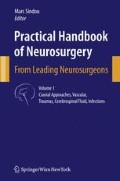Abstract
The international literature reports a prevalence of intracranial aneurysms (ICA) of around 1000 per 100,000 persons, with 85% of the ICA located on the anterior circulation around the circle of Willis, 45% of which are on the anterior communicating artery [3, 25]. The highest incidence of ICA in the population is at around 55–60 years of age.
Access this chapter
Tax calculation will be finalised at checkout
Purchases are for personal use only
Preview
Unable to display preview. Download preview PDF.
References
(1998) Unruptured intracranial aneurysms — risk of rupture and risks of surgical intervention. International study of unruptured intracranial aneurysms investigators. N Engl J Med 339: 1725–1733
Anderson CS, Feigin V, Bennett D, Lin RB, Hankey G, Jamrozik K (2004) Active and passive smoking and the risk of subarachnoid hemorrhage: an international population-based case-control study. Stroke 35: 633–637
Atkinson JL, Sundt TM Jr, Houser OW, Whisnant JP (1989) Angiographic frequency of anterior circulation intracranial aneurysms. J Neurosurg 70: 551–555
Deruty R, Dechaume JP, Lecuire J, Bret P, El OA (1976) Microsurgical treatment of a series of intracranial subtentorial arterial aneurysms. Neurochirurgie 22: 227–238
Drake CG (1981) Progress in cerebrovascular disease. Management of cerebral aneurysm. Stroke 12: 273–283
Guglielmi G, Vinuela F, Dion J, Duckwiler G (1991) Electrothrombosis of saccular aneurysms via endovascular approach. Part 2: Preliminary clinical experience. J Neurosurg 75: 8–14
Krayenbuehl HA, Yaşargil MG, Flamm ES, Tew JM Jr (1972) Microsurgical treatment of intracranial saccular aneurysms. J Neurosurg 37: 678–686
Lang J (1995) Skull base and related structures. Schattauer, Stuttgart
Linn FH, Rinkel GJ, Algra A, van GJ (1996) Incidence of subarachnoid hemorrhage: role of region, year, and rate of computed tomography: a meta-analysis. Stroke 27: 625–629
Mitchell P, Gholkar A, Vindlacheruvu RR, Mendelow AD (2004) Unruptured intracranial aneurysms: begign curiosity or ticking bomb? Lancet Neurol 3: 85–92
Molyneux A, Kerr R, Stratton I, Sandercock P, Clarke M, Shrimpton J, Holman R (2002) International subarachnoid aneurysm trial (ISAT) of neurosurgical clipping versus endovascular coiling in 2143 patients with ruptured intracranial aneurysms: a randomised trial. Lancet 360: 1267–1274
Ogilvy CS, Carter BS, Kaplan S, Rich C, Crowell RM (1996) Temporary vessel occlusion for aneurysm surgery: risk factors for stroke in patients protected by induced hypothermia and hypertension and intravenous mannitol administration. J Neurosurg 84: 785–791
Perneczky A, Fries G (1995) Use of a new aneurysm clip with an inverted-spring mechanism to facilitate visual control during clip application. Technical note. J Neurosurg 82: 898–899
Raftopoulos C (2005) Is surgical clipping becoming underused? Acta Neurochir (Wien) 147: 117–123
Raftopoulos C, Goffette P, Vaz G, Ramzi N, Scholtes JL, Wittebole X, Mathurin P (2003) Surgical clipping may lead to better results than coil embolization: results from a series of 101 consecutive unruptured intracranial aneurysms. Neurosurgery 52: 1280–1287
Raftopoulos C, Mathurin P, Boscherini D, Billa RF, Van BM, Hantson P (2000) Prospective analysis of aneurysm treatment in a series of 103 consecutive patients when endovascular embolization is considered the first option. J Neurosurg 93: 175–182
Raftopoulos C, Vaz G, Docquier M, Goffette P (2007) Neurosurgical management of inadequately embolized intracranial aneurysms: a series of 17 consecutive cases. Acta Neurochir (Wien) 149: 11–19
Rinkel GJ (2005) Intracranial aneurysm screening: indications and advice for practice. Lancet Neurol 4: 122–128
Schievink WI (1997) Intracranial aneurysms. N Engl J Med 336: 28–40
Solomon RA, Fink ME, Pile-Spellman J (1994) Surgical management of unruptured intracranial aneurysms. J Neurosurg 80: 440–446
Spetzler RF, Carter LP (1985) Revascularization and aneurysm surgery: current status. Neurosurgery 16: 111–116
Stehbens WE (1989) Etiology of intracranial berry aneurysms. J Neurosurg 70: 823–831
Tsutsumi K, Ueki K, Morita A, Usui M, Kirino T (2001) Risk of aneurysm recurrence in patients with clipped cerebral aneurysms: results of long-term follow-up angiography. Stroke 32: 1191–1194
Weir B (2002) Unruptured intracranial aneurysms: a review. J Neurosurg 96: 3–42
Wiebers DO, Whisnant JP, Huston J III, Meissner I, Brown RD Jr, Piepgras DG, Forbes GS, Thielen K, Nichols D, O’Fallon WM, Peacock J, Jaeger L, Kassell NF, Kongable-Beckman GL, Torner JC (2003) Unruptured intracranial aneurysms: natural history, clinical outcome, and risks of surgical and endovascular treatment. Lancet 362: 103–110
Yaşargil MG (1996) Clinical considerations, surgery of the intracranial aneurysms and results. Georg Thieme, Stuttgart
Yaşargil MG (1996) Microsurgical anatomy of the basal cisterns and vessels of the brain. Georg Thieme, Stuttgart
Yaşargil MG, Fox JL (1975) The microsurgical approach to intracranial aneurysms. Surg Neurol 3: 7–14
Yaşargil MG, Reichman MV, Kubik S (1987) Preservation of the frontotemporal branch of the facial nerve using the interfascial temporalis flap for pterional craniotomy. Technical article. J Neurosurg 67: 463–466
Author information
Authors and Affiliations
Editor information
Editors and Affiliations
Rights and permissions
Copyright information
© 2009 Springer-Verlag/Wien
About this chapter
Cite this chapter
Raftopoulos, C. (2009). Surgical Management of Intracranial Aneurysms of the Anterior Circulation. In: Sindou, M. (eds) Practical Handbook of Neurosurgery. Springer, Vienna. https://doi.org/10.1007/978-3-211-84820-3_17
Download citation
DOI: https://doi.org/10.1007/978-3-211-84820-3_17
Publisher Name: Springer, Vienna
Print ISBN: 978-3-211-84819-7
Online ISBN: 978-3-211-84820-3
eBook Packages: MedicineMedicine (R0)

